
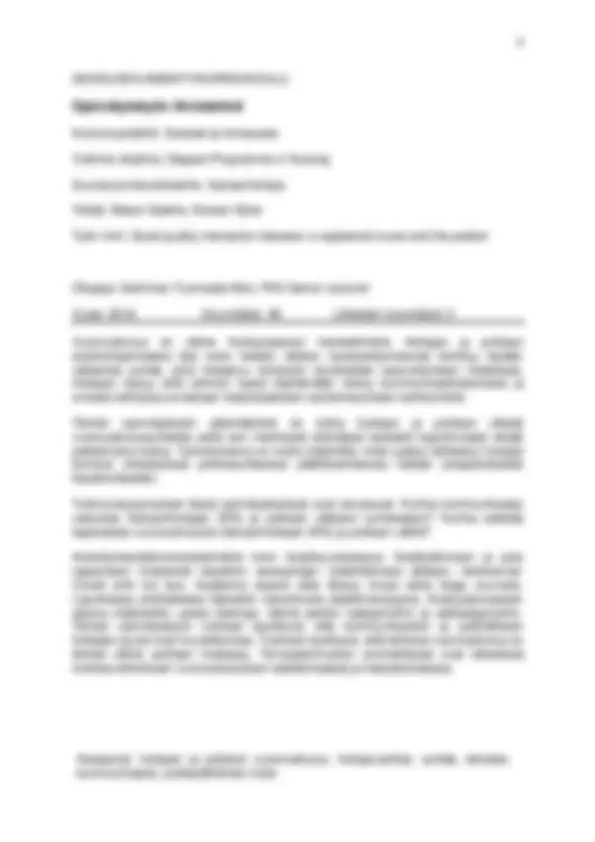
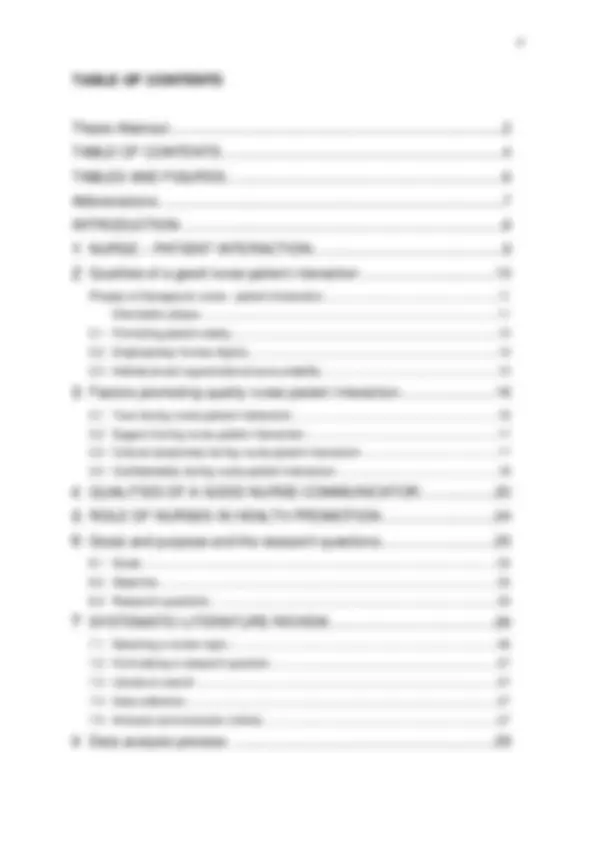
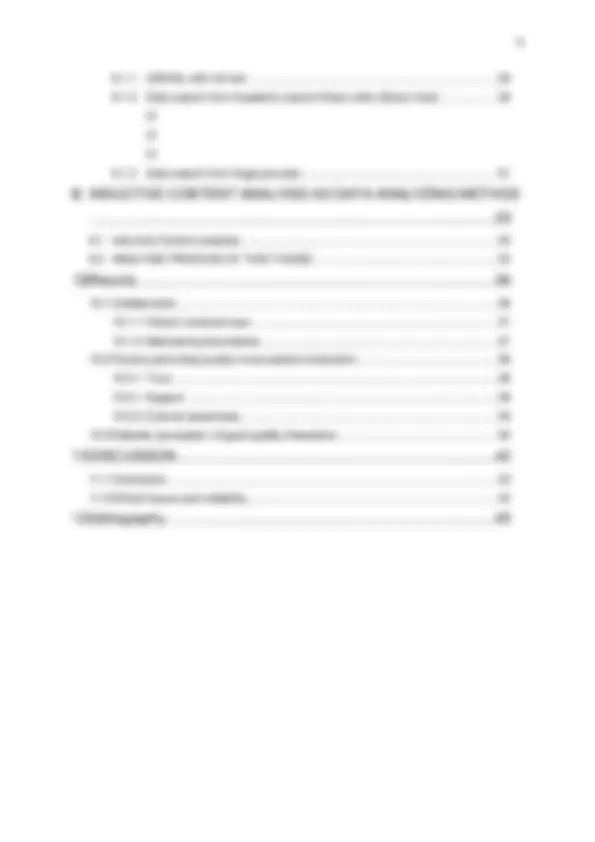
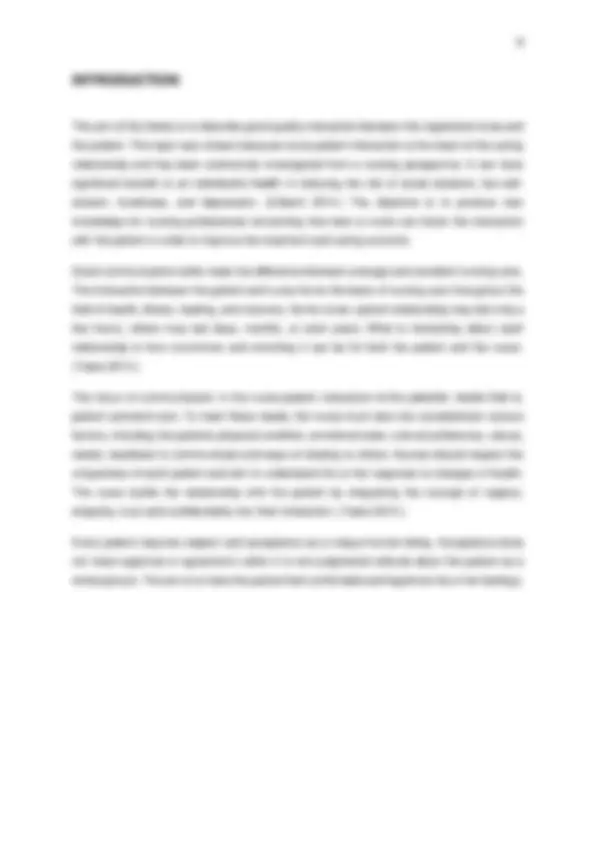
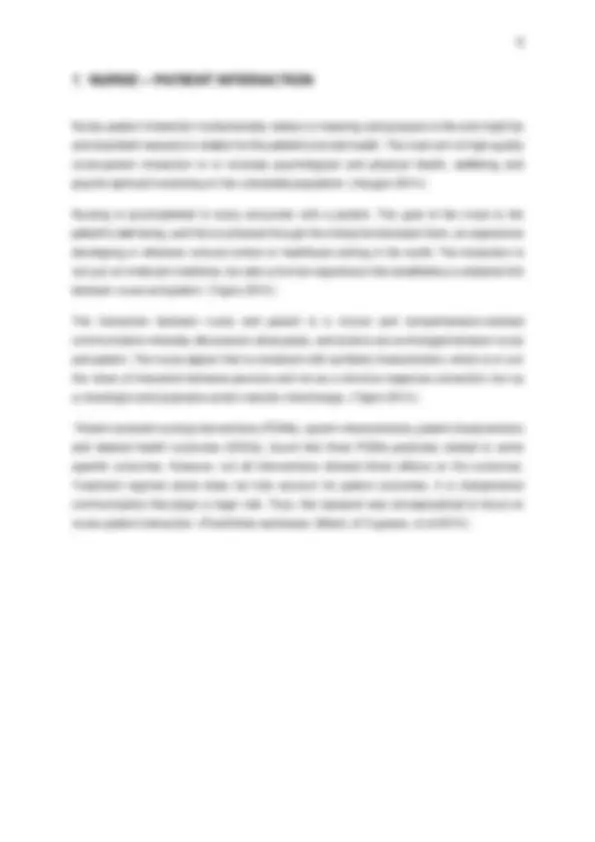
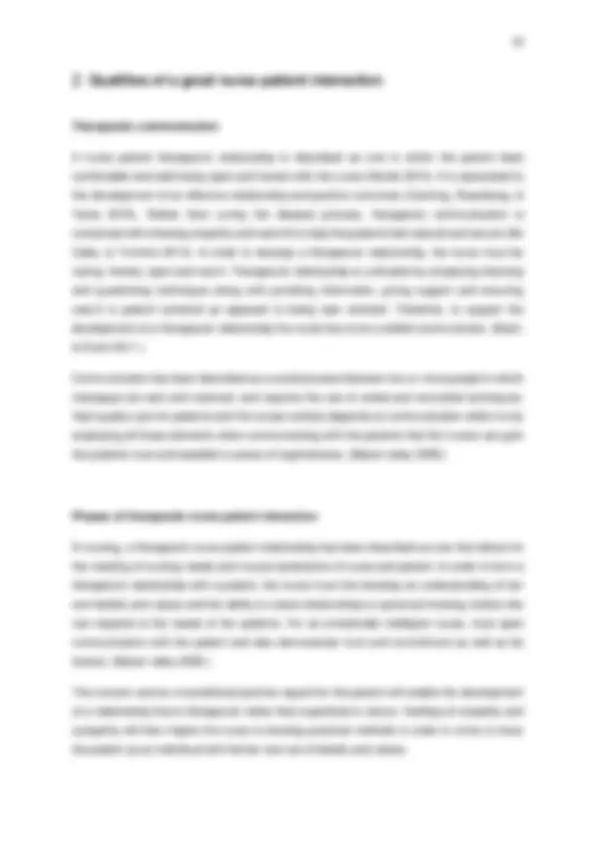
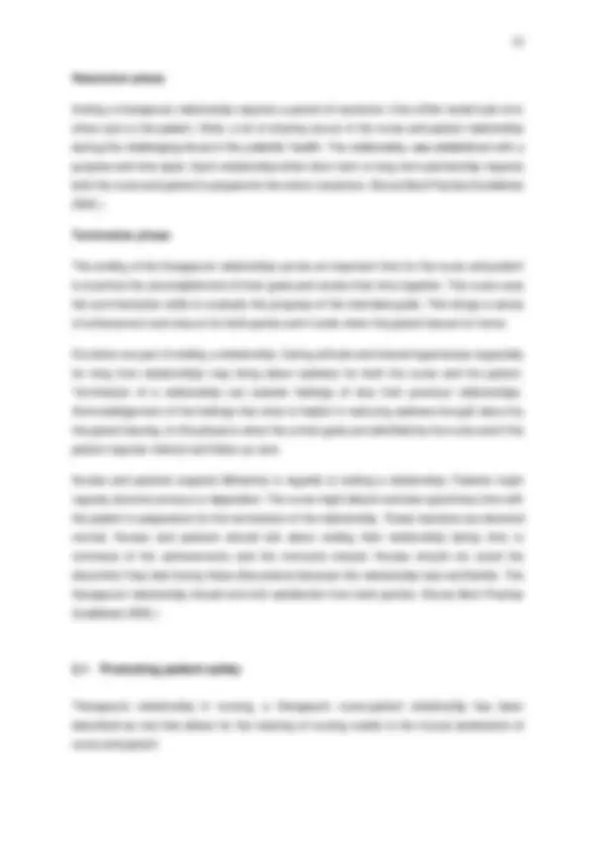
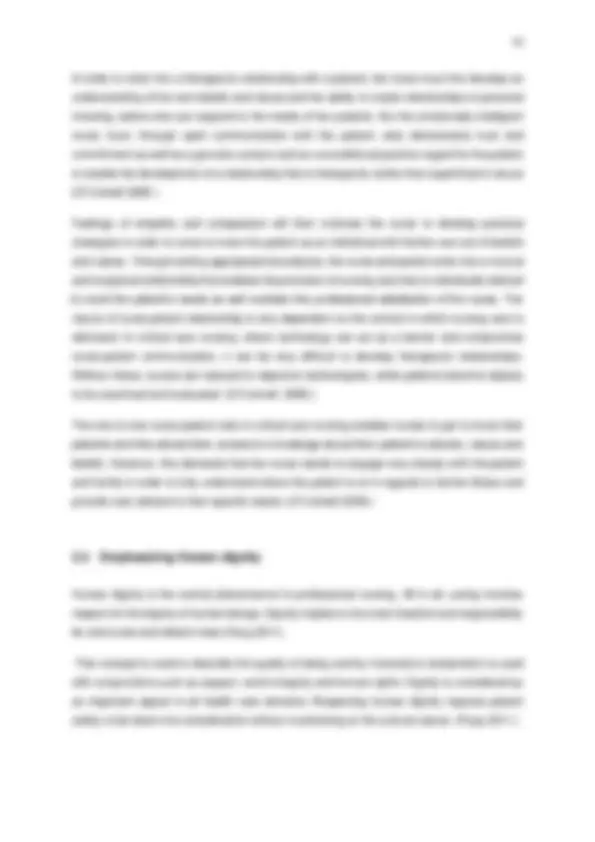
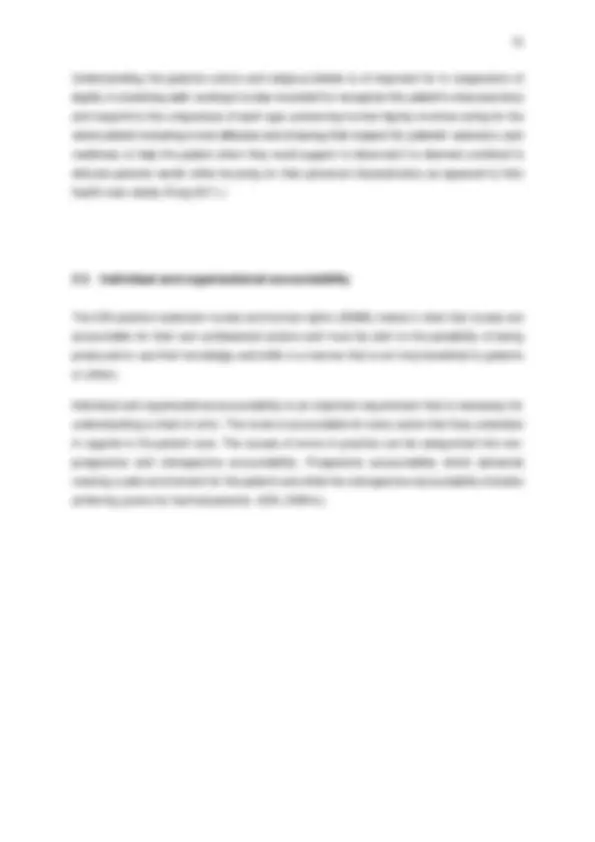
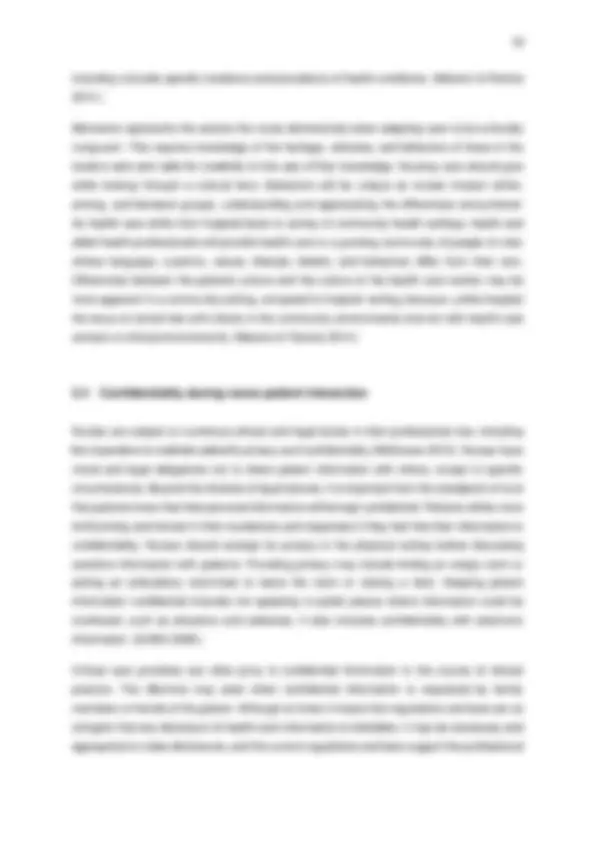

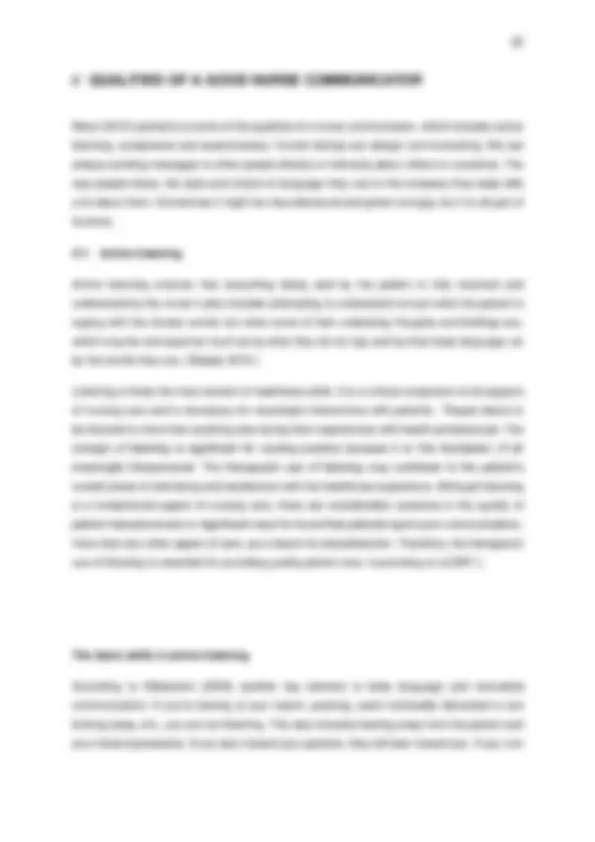
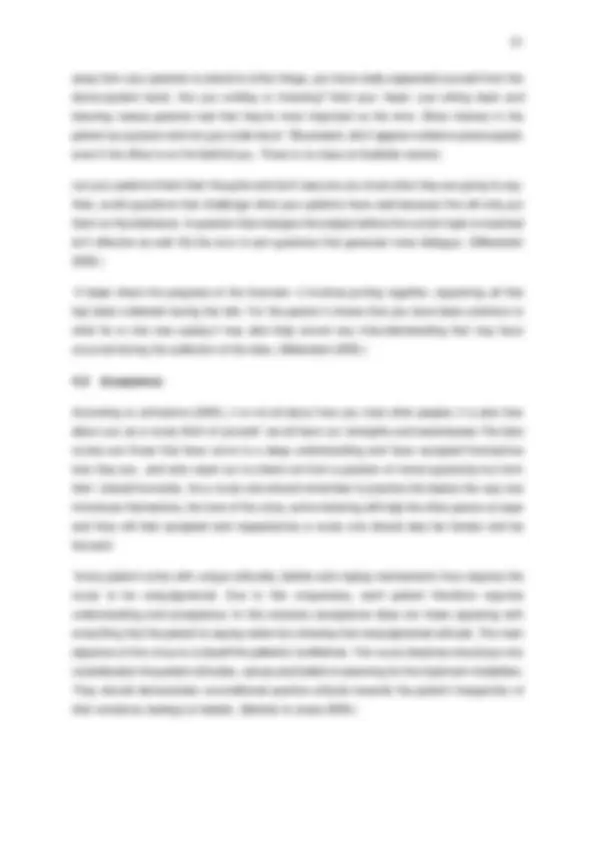
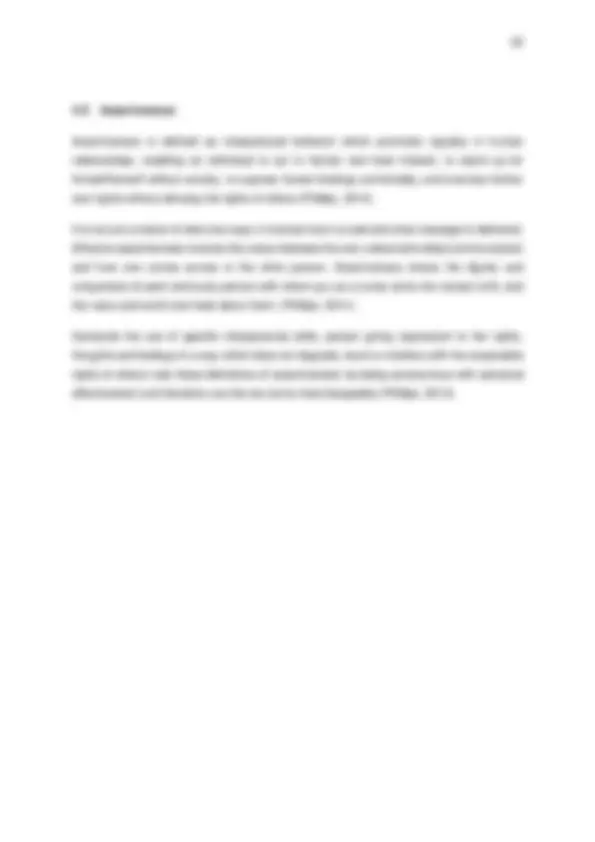
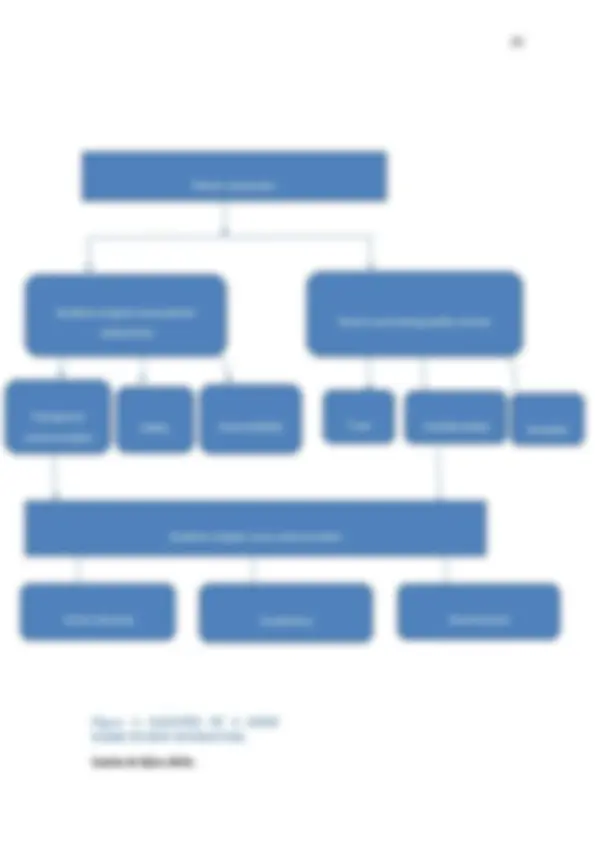
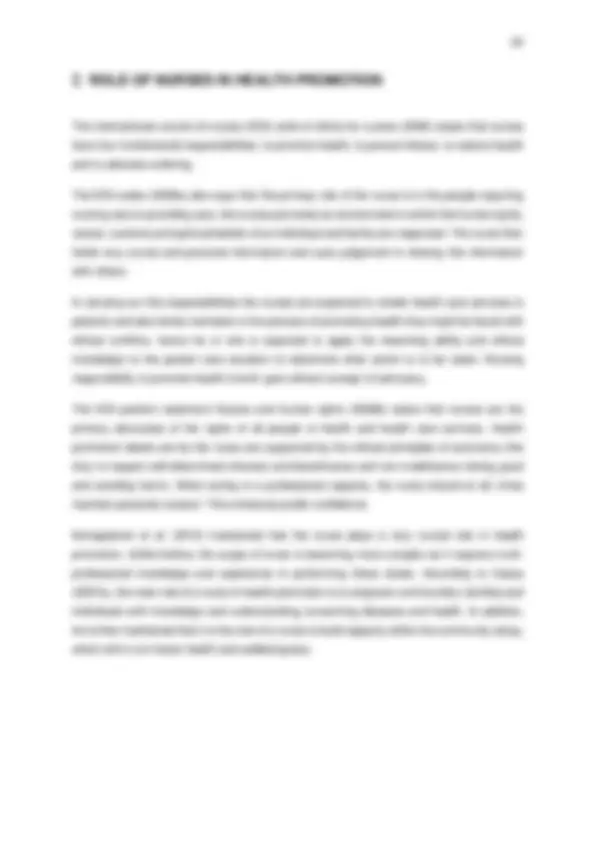
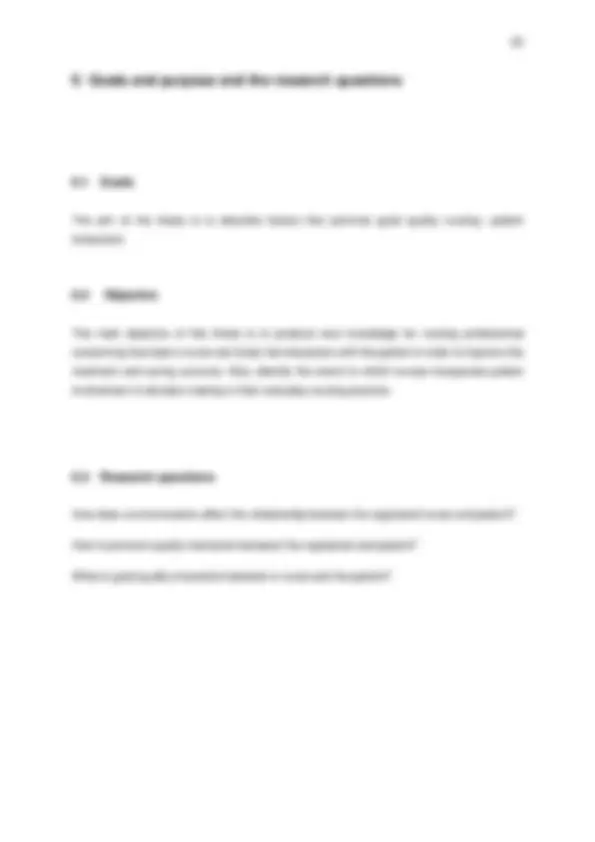
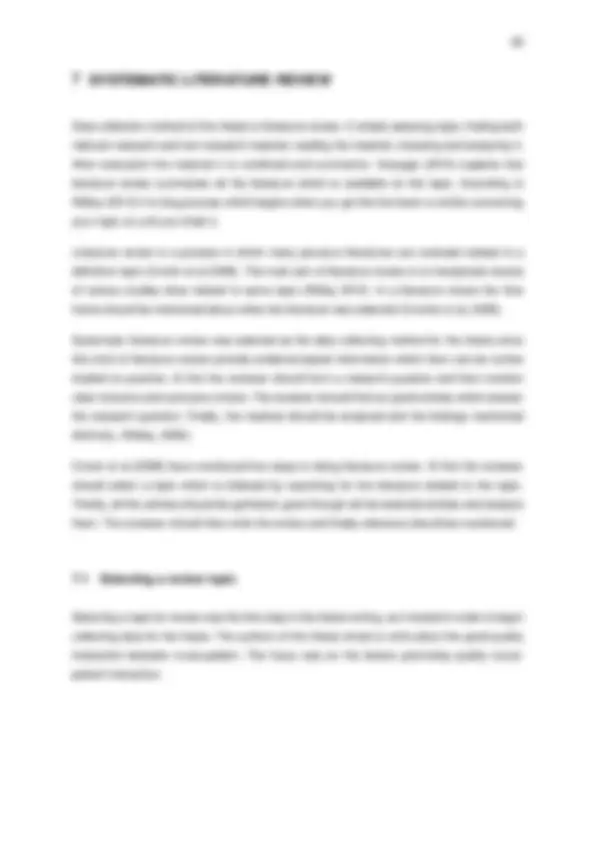
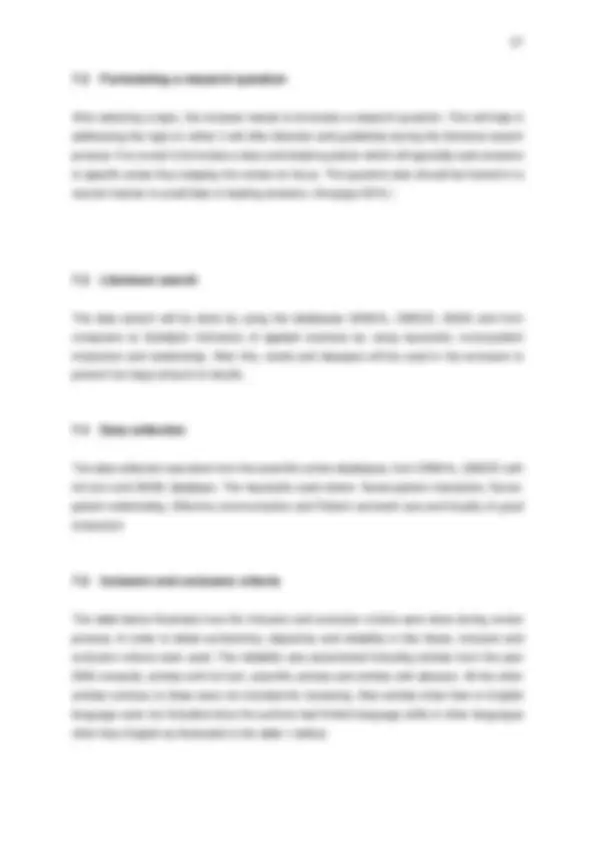
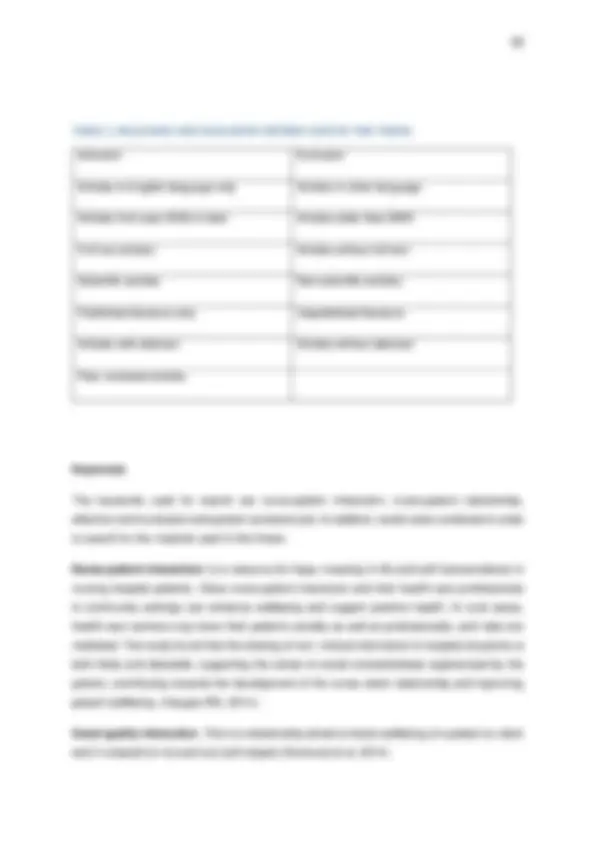
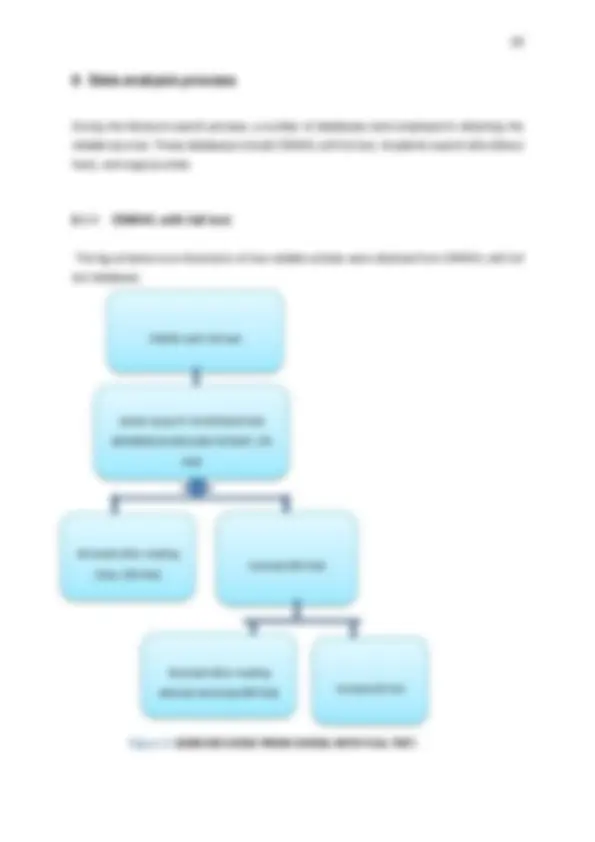
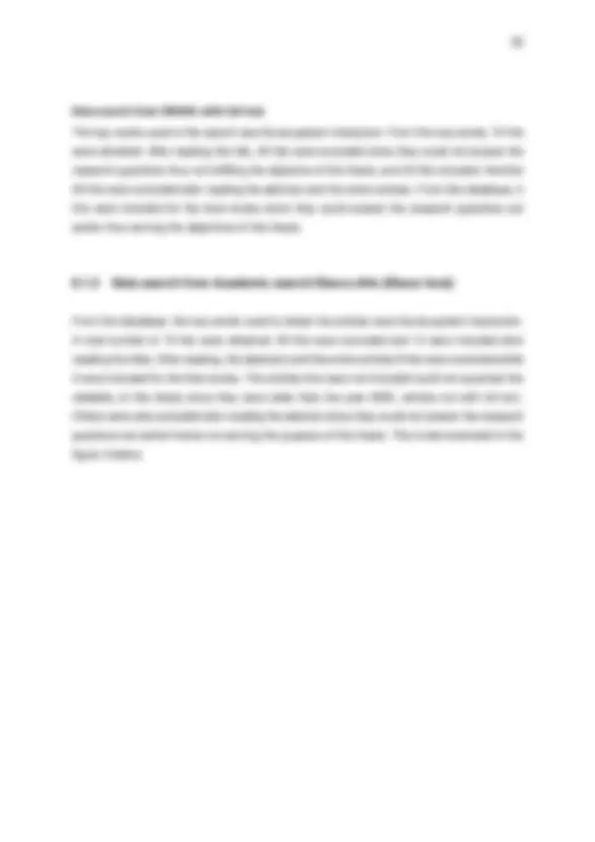
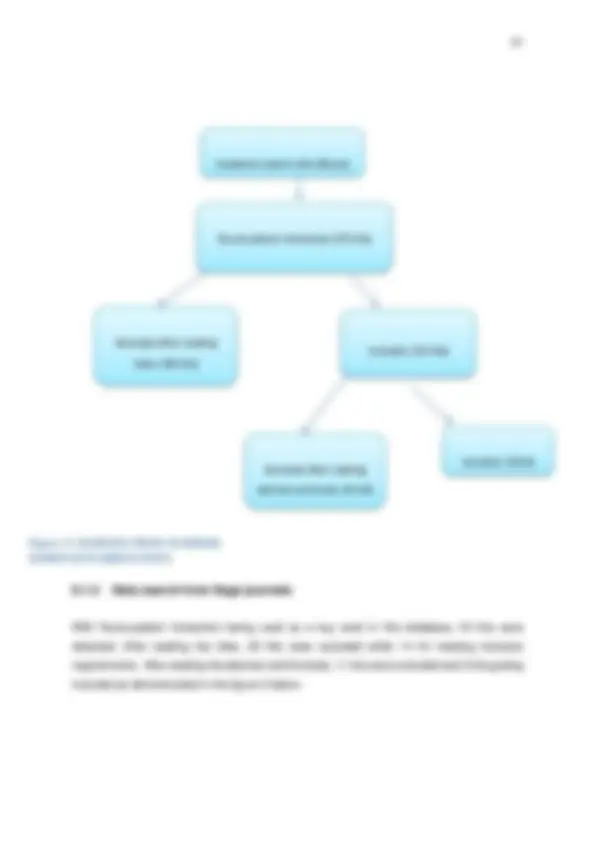
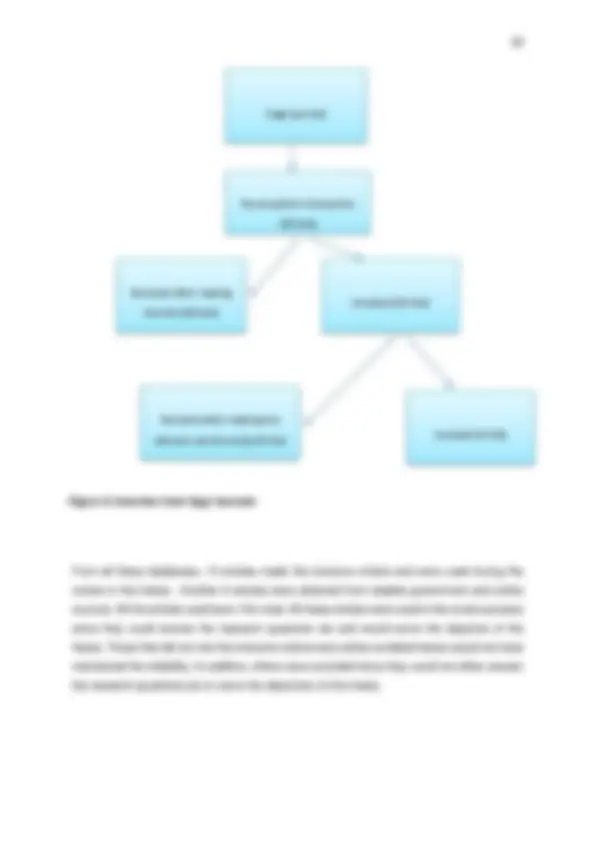
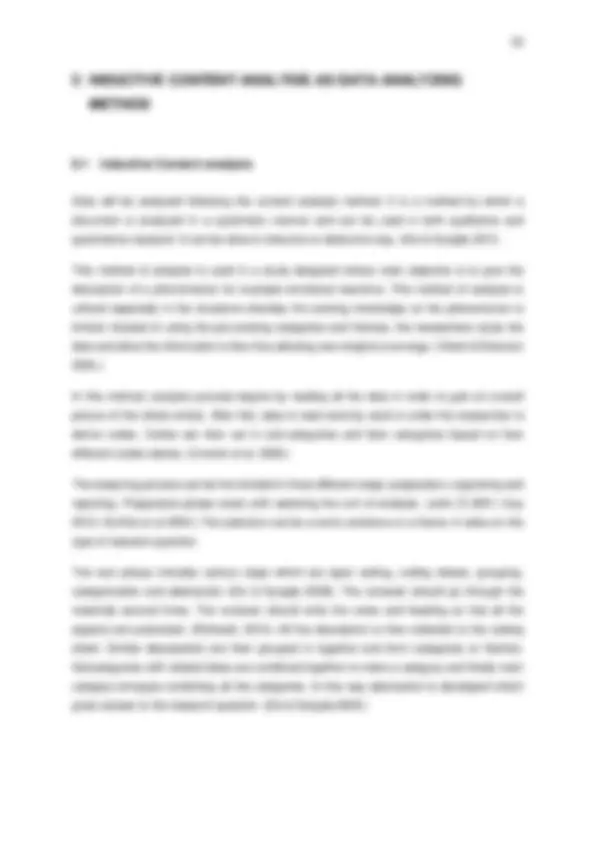
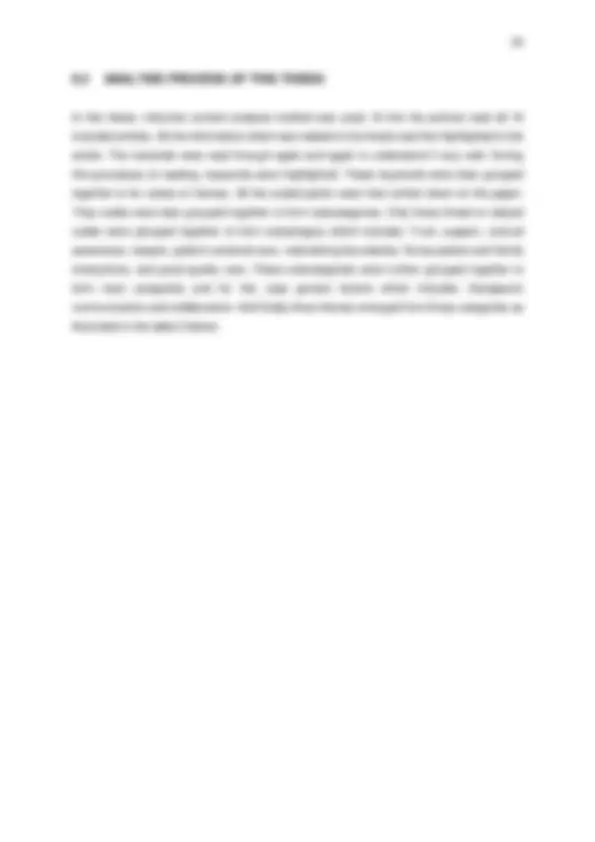
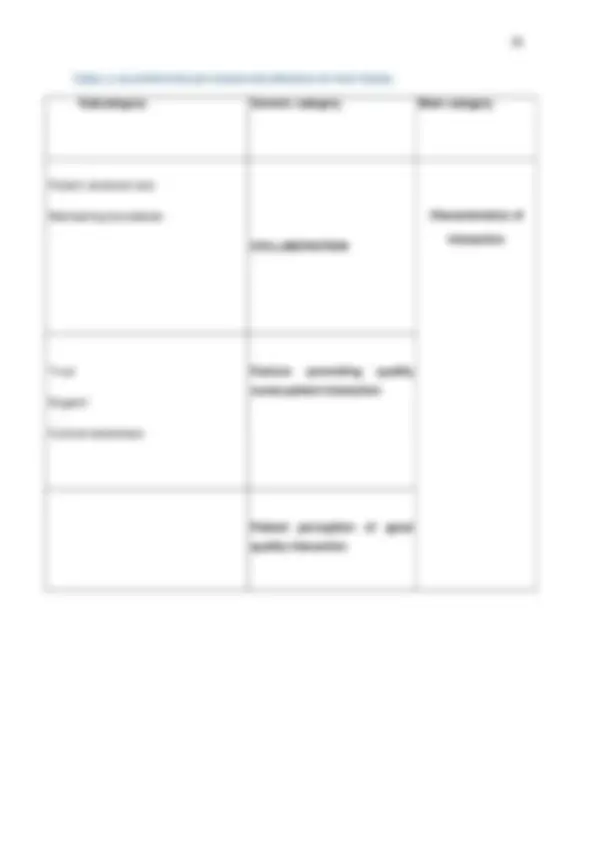
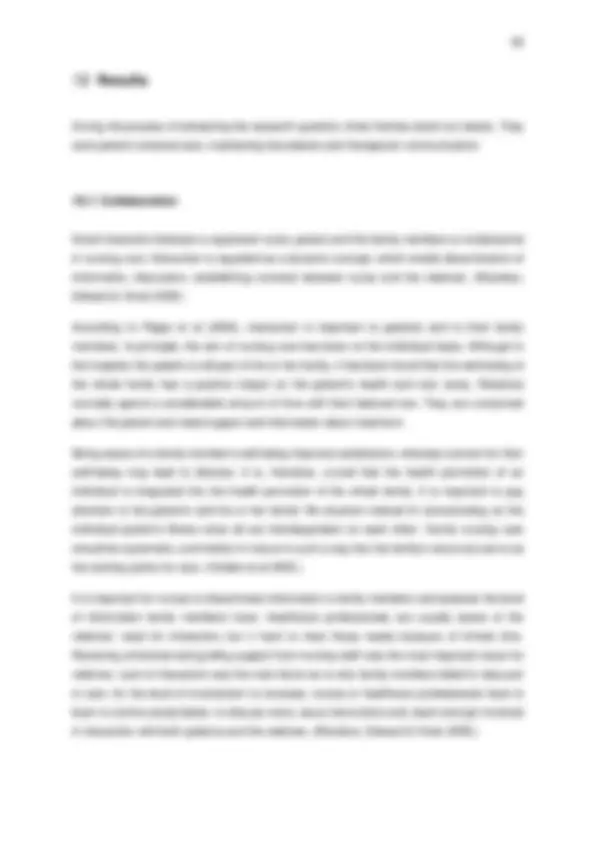
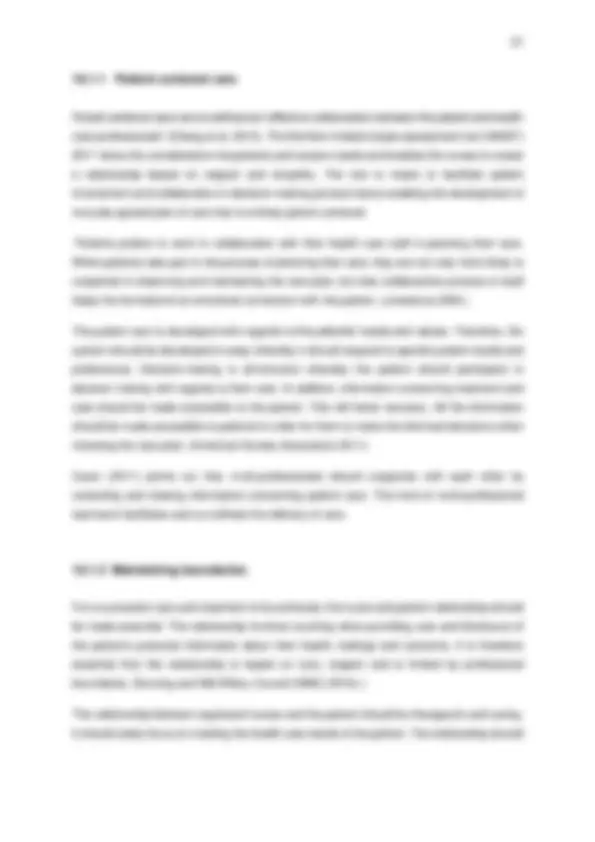
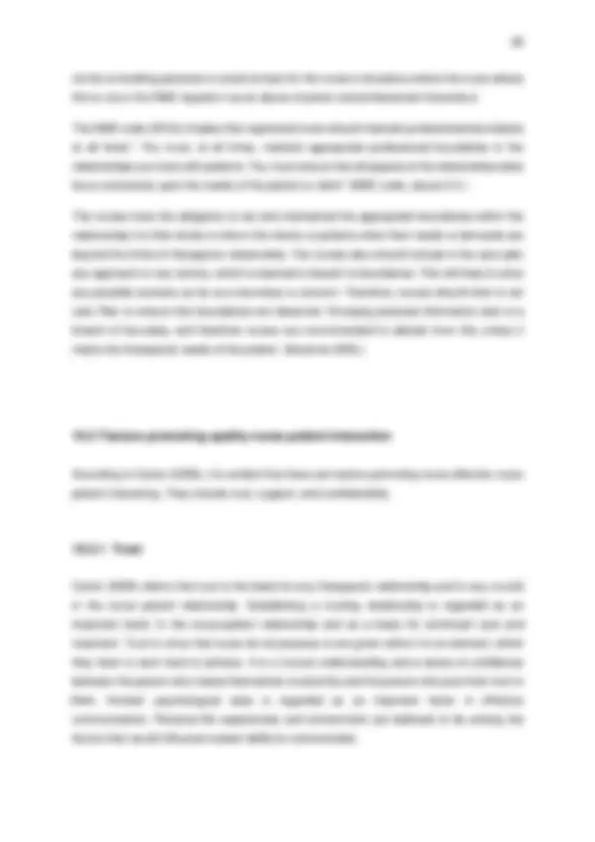
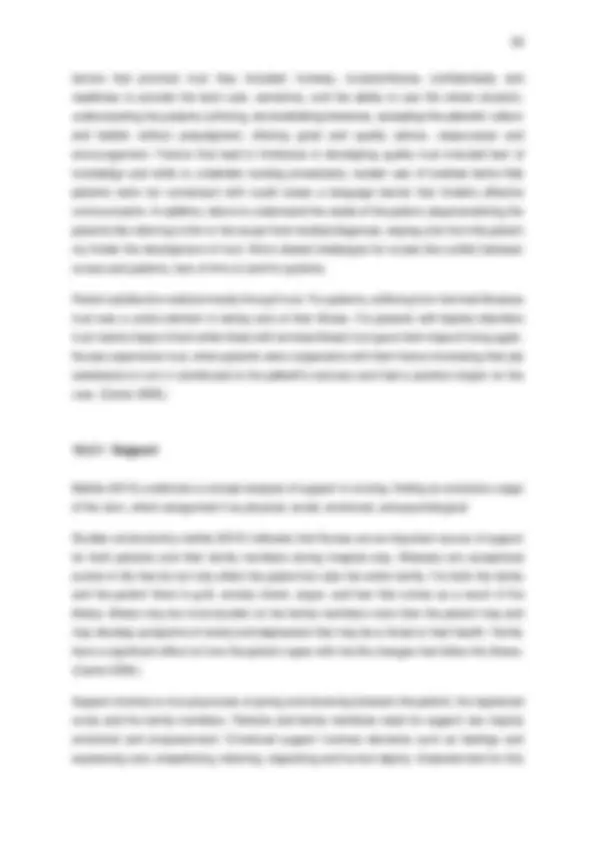
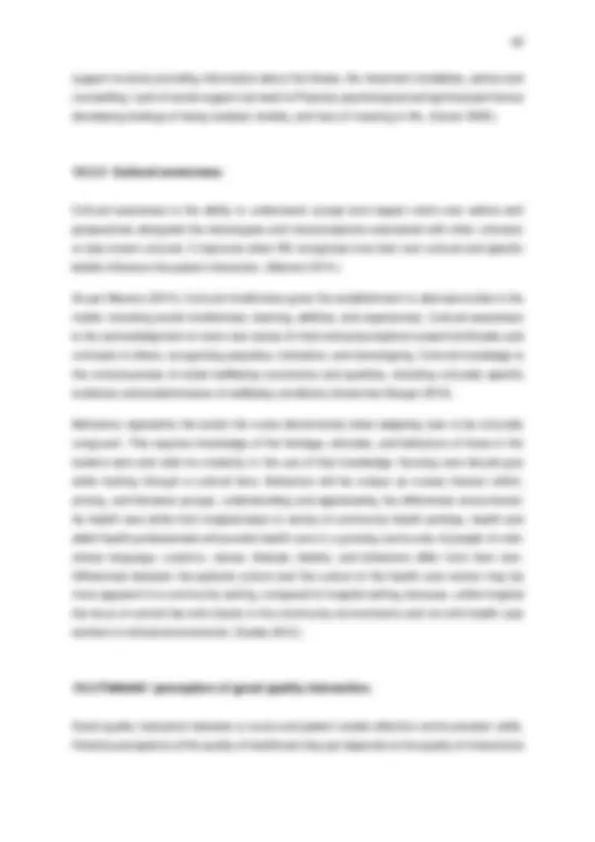
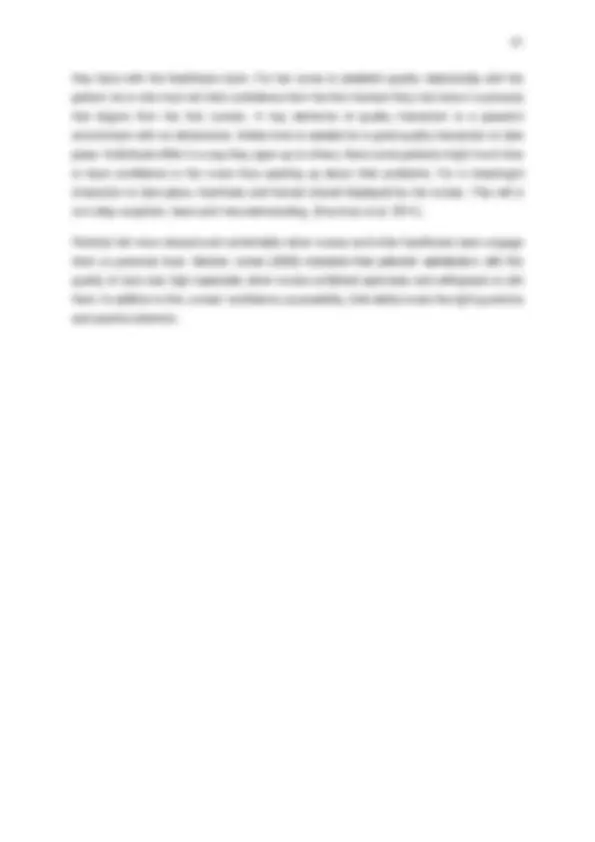
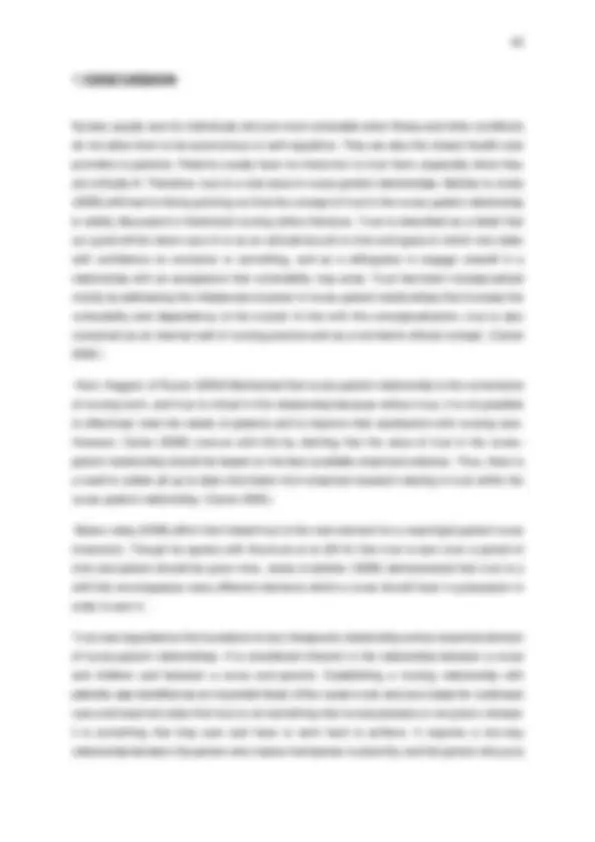
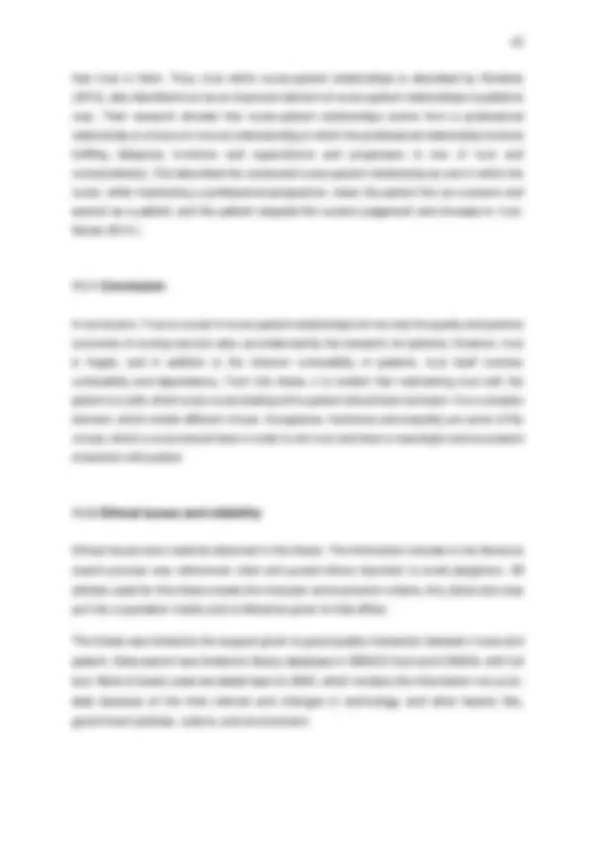
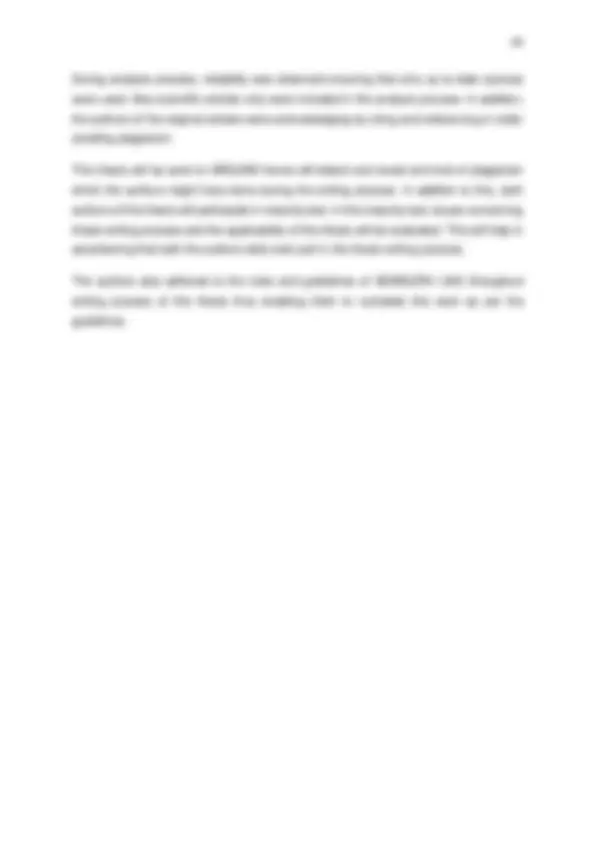
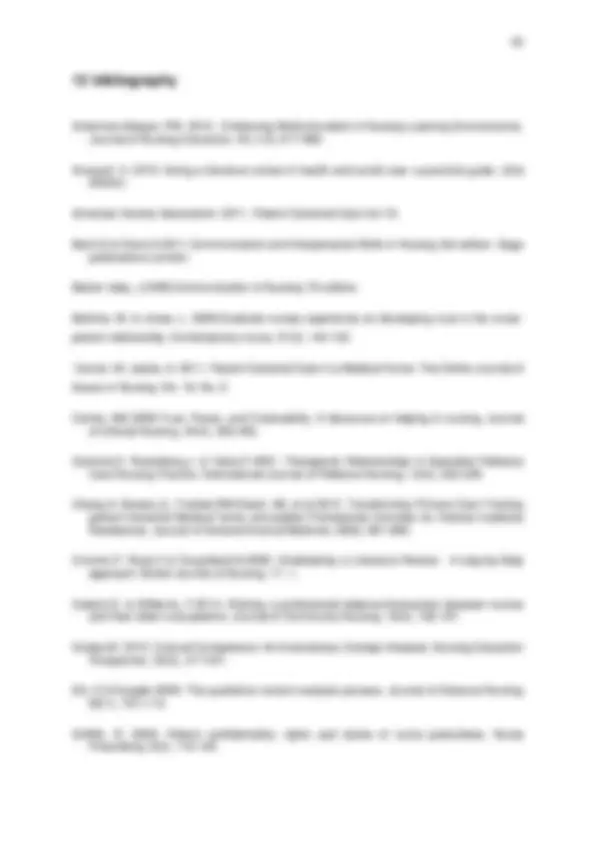
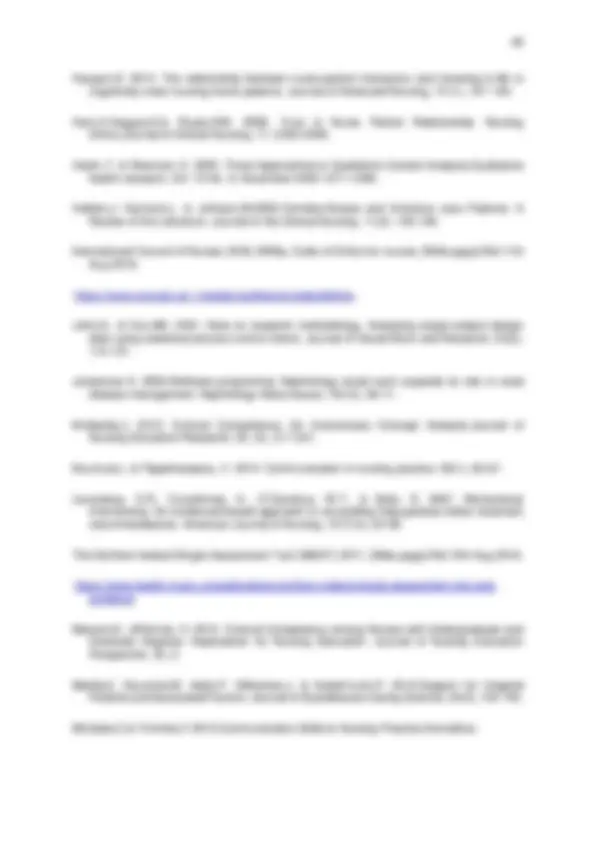
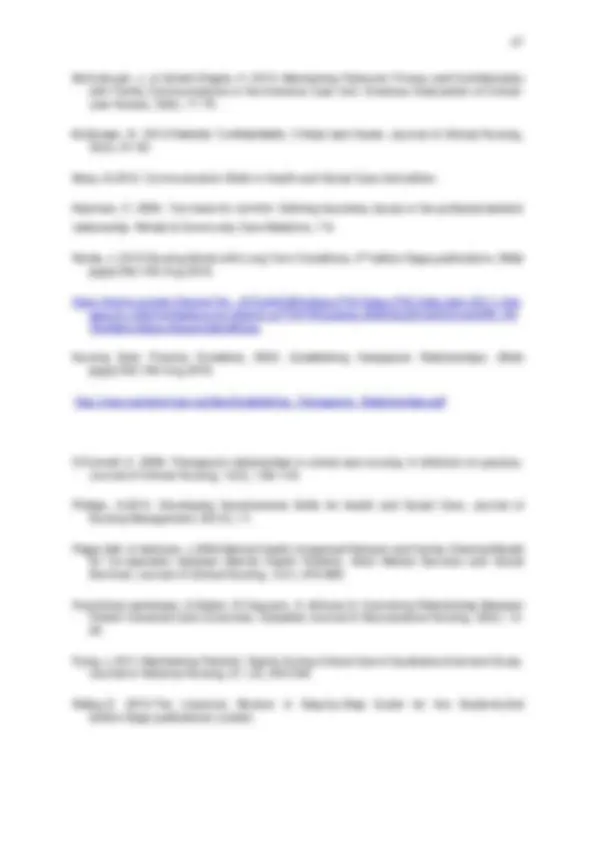
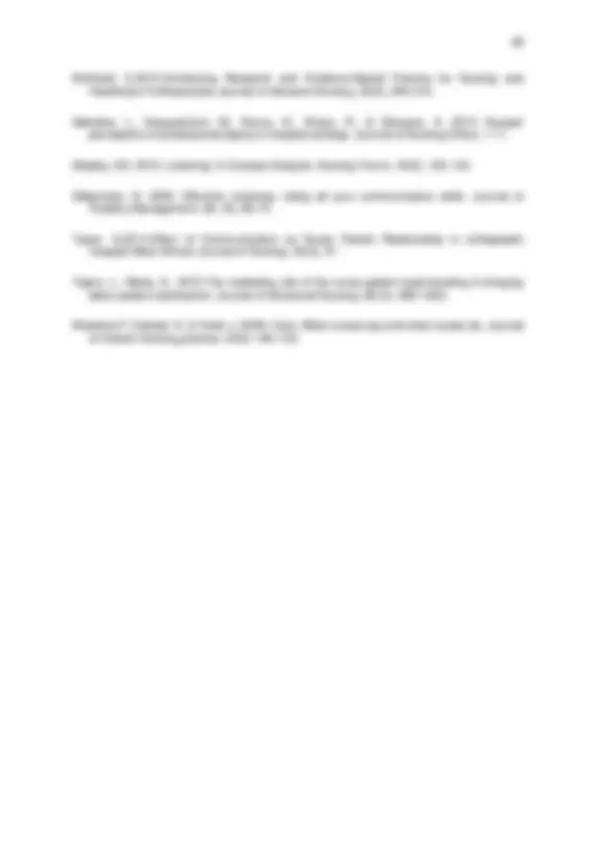


Study with the several resources on Docsity

Earn points by helping other students or get them with a premium plan


Prepare for your exams
Study with the several resources on Docsity

Earn points to download
Earn points by helping other students or get them with a premium plan
Community
Ask the community for help and clear up your study doubts
Discover the best universities in your country according to Docsity users
Free resources
Download our free guides on studying techniques, anxiety management strategies, and thesis advice from Docsity tutors
The significance of trust in the nurse-patient relationship, emphasizing its role in promoting effective communication, self-transcendence, and positive nursing care outcomes. the importance of therapeutic communication, confidentiality, and individualized care in fostering trust and mutual understanding between nurses and patients.
What you will learn
Typology: Study notes
1 / 48

This page cannot be seen from the preview
Don't miss anything!









































Thesis Autum 2016 Faculty: Social work and Healthcare Degree Programme: Nursing
Faculty:social work and healthcare Degree programme: Degree Programme in Nursing Author/s: Bakari Salehe, Doreen Njine Title of thesis: Good quality interaction between a registered nurse and the patient Supervisor/s: Mari Salminen – Tuomaala, : PhD, Senior lecturer Year: 2016 Pages: 48 Number of appendices: Interaction is the vehicle for the application of the nursing process. From the time, the nurse meets the client first and throughout their contacts, progress in relating to each other will be reflected in the degree of accomplishment of the nursing care goals. The nurse must therefore be able to use knowledge of communication theory and of the development of self to facilitate the growth of the helping relationship The aim of this thesis is to investigate the relationship between nurse and patient interaction and meaning in life among cognitively intact nursing palliative care. In addition, to identify the extent to which Registered Nurses involve patients in decision making in everyday nursing practice. The research questions of this thesis are: How does communication affect the relationship between the RG and patient? How to promote quality interaction between the RG and patient? Data collection method is literature review: Inclusion and exclusion criteria is used after the keywords are identified, data bases used are: CINAHL with full text, Academic search elite Ebsco (host) and Sage journals. A total Articles are used inductive content analysis is used. During analysis process, several themes are identified then divided into categories and subcategories. The result of this thesis suggests that effective communication is an important tool in patient care. Health care professionals play an important role in promoting and facilitating effective communication Keywords : Nurse-patient interaction, nurse-patient relationship, effective communication, patient centered care.
PCNIs Patient Centered Nursing Interventions DHOs Desired Health Outcomes ICN International Council of Nurses RG Registered Nurse NISAT The Northern Ireland single assessment tool NMC Nursing and Midwifery Council NBPG Nurse Best Practice Guidelines
The aim of the thesis is to describe good quality interaction between the registered nurse and the patient. This topic was chosen because nurse patient interaction is the heart of the caring relationship and has been extensively investigated from a nursing perspective. It can have significant benefit to an individual’s health in reducing the risk of social isolation, low self- esteem, loneliness, and depression. (Cobertt 2014.) The objective is to produce new knowledge for nursing professional concerning how best a nurse can foster the interaction with the patient in order to improve the treatment and caring outcome. Good communication skills make the difference between average and excellent nursing care. The interaction between the patient and nurse forms the basis of nursing care throughout the field of health, illness, healing, and recovery. Some nurse- patient relationship may last only a few hours, others may last days, months, or even years. What is interesting about each relationship is how uncommon and enriching it can be for both the patient and the nurse. (Taiwo 2014.) The focus of communication in the nurse-patient interaction is the patients’ needs that is, patient centered care. To meet these needs, the nurse must take into consideration various factors, including the patients physical condition, emotional state, cultural preference, values, needs, readiness to communicate and ways of relating to others. Nurses should respect the uniqueness of each patient and aim to understand his or her response to changes in health. The nurse builds the relationship with the patient by integrating the concept of respect, empathy, trust and confidentiality into their interaction. (Taiwo 2 0 14.) Every patient requires respect and acceptance as a unique human being. Acceptance does not mean approval or agreement; rather it is non-judgmental attitude about the patient as a whole person. The aim is to make the patient feel comfortable and legitimize his or her feelings.
Therapeutic communication A nurse patient therapeutic relationship is described as one in which the patient feels comfortable and safe being open and honest with the nurse (Nicole 2015 ). It is associated to the development of an effective relationship and positive outcomes (Canning, Rosenberg, & Yates 2016 ). Rather than curing the disease process, therapeutic communication is concerned with showing empathy and warmth to help the patients feel relaxed and secure (Mc Cabe, & Timmins 20 13 ). In order to develop a therapeutic relationship, the nurse must be caring, honest, open and warm. Therapeutic relationship is cultivated by employing listening and questioning techniques along with providing information, giving support and ensuring care.It is patient centered as opposed to being task oriented. Therefore, to support the development of a therapeutic relationship the nurse has to be a skilled communicator. (Bach, & Grant 2011.) Communication has been described as a social process between two or more people in which messages are sent and received, and requires the use of verbal and nonverbal techniques. High quality care for patients and the nurses entirely depends on communication skills.it is by employing all these elements when communicating with the patients that the nurses can gain the patients trust and establish a sense of togetherness. (Balzer-railey 2008 .) Phases of therapeutic nurse patient interaction In nursing, a therapeutic nurse-patient relationship has been described as one that allows for the meeting of nursing needs and mutual satisfaction of nurse and patient. In order to form a therapeutic relationship with a patient, the nurse must first develop an understanding of her own beliefs and values and her ability to create relationships or personal knowing, before she can respond to the needs of her patients. For an emotionally intelligent nurse, must open communication with the patient and also demonstrate trust and commitment as well as be honest. (Balzer-railey 2008.) The concern and an unconditional positive regard for the patient will enable the development of a relationship that is therapeutic rather than superficial in nature. Feelings of empathy and sympathy will then inspire the nurse to develop practical methods in order to come to know the patient as an individual with his/her own set of beliefs and values.
Through setting appropriate boundaries, the nurse and patient enter into a mutual and respective relationship that enables the provision of nursing care that is individually designed to meet the patient’s needs as well maintain the professional satisfaction of the nurse. The nature of nurse-patient relationship is very dependent on the situation in which nursing care is delivered. In critical care nursing, where technology can act as a wall and compromise nurse- patient communication, it can be very difficult to develop therapeutic relationships. Without these, nurses are reduced to objective technologists, while patients become objects to be examined and evaluated. The one-to-one nurse-patient ratio in critical care nursing enables nurses to get to know their patients and this allows them access to knowledge about their patient’s cultures, values and beliefs. However, this demands that the nurse needs to get involved very closely with the patient and family in order to fully understand where the patient is at in regards to his/her illness and provide care tailored to their specific needs. (Balzer-railey 2008.)
The nurse – patient process includes; orientation phase, identification phase, exploitation phase, resolution phase, and termination phase.
The start of nurse patient interaction requires special communication skills. In day to day life people communicate with those around them through listening, sharing, talking, reassuring and caring. Registered nurses use these components of communication to establish a relationship. The nurse sets the nature of the relationship by greeting the patient in a proper manner. The tone and enthusiasm used during this exchange promotes connection between the registered nurse and patient. Often a handshake is an appropriate introduction component but this varies with different cultural settings and severity of the clinical situation. Patients are first addressed by their formal names then are asked which names they would prefer to be used. Establishing a rapport may begin with talking about clinical relevant topics or social disclosure like the weather, environment. Registered nurse establishes their trust by being consistent in their words and actions. This consistency conveys dependability and competence. (Nurse Best Practise Guidelines 2002)
Resolution phase Ending a therapeutic relationship requires a period of resolution. One of the nurse’s job is to show care to the patient. Often, a lot of sharing occurs in the nurse and patient relationship during the challenging times in the patients’ health. The relationship was established with a purpose and time span. Each relationship either short term or long term partnership requires both the nurse and patient to prepare for the end or resolution. (Nurse Best Practise Guidelines 2002 .) Termination phase The ending of the therapeutic relationship can be an important time for the nurse and patient to examine the accomplishment of their goals and review their time together. The nurse uses the summarization skills to evaluate the progress of the intended goals. This brings a sense of achievement and closure for both parties and it ends when the patient leaves for home Emotions are part of ending a relationship. Caring attitude and shared experiences especially for long time relationships may bring about sadness for both the nurse and the patient. Termination of a relationship can awaken feelings of loss from previous relationships. Acknowledgement of the feelings that arise is helpful in reducing sadness brought about by the patient leaving. In this phase is when the unmet goals are identified by the nurse and if the patient requires referral and follow up care. Nurses and patients respond differently in regards to ending a relationship. Patients might regress, become anxious or dependent. The nurse might detach and also spend less time with the patient in preparation for the termination of the relationship. These reactions are deemed normal. Nurses and patients should talk about ending their relationship taking time to reminisce of the achievements and the moments shared. Nurses should not avoid the discomfort they feel during these discussions because the relationship was worthwhile. The therapeutic relationship should end with satisfaction from both parties. (Nurse Best Practise Guidelines 2002.)
Therapeutic relationship in nursing, a therapeutic nurse-patient relationship has been described as one that allows for the meeting of nursing needs to the mutual satisfaction of nurse and patient.
In order to enter into a therapeutic relationship with a patient, the nurse must first develop an understanding of her own beliefs and values and her ability to create relationships or personal knowing, before she can respond to the needs of her patients. But the emotionally intelligent nurse must, through open communication with the patient, also demonstrate trust and commitment as well as a genuine concern and an unconditional positive regard for the patient to enable the development of a relationship that is therapeutic rather than superficial in nature (O’Connell 2008.) Feelings of empathy and compassion will then motivate the nurse to develop practical strategies in order to come to know the patient as an individual with his/her own set of beliefs and values. Through setting appropriate boundaries, the nurse and patient enter into a mutual and reciprocal relationship that enables the provision of nursing care that is individually tailored to meet the patient’s needs as well maintain the professional satisfaction of the nurse. The nature of nurse-patient relationship is very dependent on the context in which nursing care is delivered. In critical care nursing, where technology can act as a barrier and compromise nurse-patient communication, it can be very difficult to develop therapeutic relationships. Without these, nurses are reduced to objective technologists, while patients become objects to be examined and evaluated. (O’Connell, 2008.) The one-to-one nurse-patient ratio in critical care nursing enables nurses to get to know their patients and this allows them access to knowledge about their patient’s cultures, values and beliefs. However, this demands that the nurse needs to engage very closely with the patient and family in order to fully understand where the patient is at in regards to his/her illness and provide care tailored to their specific needs. (O’Connell 2008.)
Human dignity is the central phenomenon in professional nursing. All in all, caring involves respect for the dignity of human beings. Dignity implies to the inner freedom and responsibility for one’s own and others’ lives (Pyng 2011 ). This concept is used to describe the quality of being worthy, honored or esteemed.it is used with conjunctions such as respect, worth integrity and human rights. Dignity is considered as an important aspect in all health care domains. Respecting human dignity requires patient safety to be taken into consideration without overlooking at the cultural values. (Pyng 2011 .)
It is evident that there are factors promoting nurse effective nurse patient interacting. They include trust, support, and confidentiality (Carter 2009).
Carter ( 2009 ) claims that trust is regarded as the basis for any therapeutic relationship and is essential in the nurse patient relationship. Establishing a trusting relationship is regarded as an important face in the nurse role and as a basis for continued care and treatment. (Hem, Heggen & Ruyter 2008) that trust is not something that nurse possess or are given rather it is something they have to work hard to achieve. It is a two-way thing between the person who makes themselves trustworthy and the person who puts their trust in them. Nurses’ state of mind is regarded as an important tool in effective communication. Personal life and environment is regarded as a factor that would influence nurses’ ability to communicate. There are several factors that were shortlisted that promote trust they included: honesty, trustworthiness, confidentiality and readiness to provide the best care, humility, sensitivity, and the ability to see the whole situation, understanding the patients suffering, demonstrating tolerance and tolerance, accepting the patients’ culture and decisions without prejudgment, offering good and quality advice, reassurance and encouragement. Several factors were also highlighted to be a hindrance to quality trust. They included: lack of knowledge and skills to undertake nursing procedures, nurses’ use of medical terms that patients were not familiar with could create a language barrier that hinders effective communication, failure to understand the needs of the patient, depersonalizing the patients like referring to him or her as per their medical diagnosis, staying a far from the patient. Work related challenges for nurses like conflict between nurses and patients, lack of time to tend for patients. (Hem, Heggen, & Ruyter 2008 .) Studies show that patient satisfaction is achieved greatly through trust. For patients, suffering from chronic illnesses trust was a meaningful and component in shaping their illness. For patients with personal disorders trust gave they hope and for the dying patients trust gave them an incentive of living. For nurses, when trust developed patients were more compliant with the care thus increasing job satisfaction.in turn it contributed to the patient’s recovery and
had a positive impact on the care. It also allowed nurses to undertake painful procedures without stress. (Hem,Heggen, & Ruyter 2008.)
Mattila (2010) undertook a concept analysis of support in nursing, finding an extensive usage of the term, which categorized it as physical, social, emotional, and psychological. She claims that Nurses are an important source of support for patients and family members during hospitalization. Serious illness are exceptional events in life that do not only affect the patient but also the whole family. For both the family and the patient there is shock, anger, guilt, anxiety and fear that comes about because of the illness. In some cases, some family members may be burdened by the illness more than the patient and may develop long term symptoms of stress and depression that may be a threat to their health. Family members are a source of support to the patient and have a significant effect on how the patient copes with the life changes that follow the illness. Support evolves in an interactive process of giving and receiving between the patient, nurse and the family members. Patients and family members need for support are primarily on the areas of emotional and informational support. Emotional support involves elements such as feelings and expressing care, empathizing, listening, respecting and human dignity. Informational support involves provision of information, advice and counselling.it is possible to provide support to patients in all stages of life. Physical, psychological and spiritual pain maybe caused by lack of social support that can lead to patient isolation, loneliness, and loss of meaning in life. (Mattila, Kaunonen, Aalto et al 2010.)
Cultural awareness is the ability to understand one’s own culture and perspectives alongside the stereotypes and misconceptions associated with other unknown or less known cultures.it is the first step of providing a culturally competent care. It improves when RG recognizes how their own cultural and specific beliefs influence the patient interaction. Cultural awareness provides the foundation for the other constructs in the model, including cultural awareness, knowledge, skills, and encounters. Cultural awareness is the recognition of one’s own attitudes and assumptions toward similarities and differences in others, acknowledging racism, bias, and stereotyping. Cultural knowledge is the awareness of cultural health beliefs and values,
judgment in communicating patient’s health information.The duty of confidence is fundamental aspect of the nurse-patient relationship, but it is not absolute. There will be occasions where confidential information about a patient will need to be disclosed to others. Such a disclosure must be to an appropriate person and comply with the requirements of your contractual, professional and legal duty of confidence, or you will be called to account and face sanction for breaching confidentiality. (McCullough 2013.)
Moss (2012) pointed out some of the qualities of a nurse communicator, which includes active listening, acceptance and assertiveness. Human beings are always communicating. We are always sending messages to other people directly or indirectly about others or ourselves. The way people dress, the style and choice of language they use to the company they keep tells a lot about them. Sometimes it might be misunderstood and gotten wrongly, but it is all part of humans.
Active listening ensures that everything being said by the patient is fully received and understood by the nurse it also includes attempting to understand not just what the patient is saying with the chosen words, but what some of their underlying thoughts and feelings are, which may be conveyed as much as by what they do not say and by their body language, as by the words they use. (Shipley 2010.) Listening is likely the most ancient of healthcare skills. It is a critical component of all aspects of nursing care and is necessary for meaningful interactions with patients. People desire to be listened to more than anything else during their experiences with health professionals. The concept of listening is significant for nursing practice because it is “the foundation of all meaningful interpersonal. The therapeutic use of listening may contribute to the patient’s overall sense of well-being and satisfaction with the healthcare experience. Although listening is a fundamental aspect of nursing care, there are considerable variations in the quality of patient interactions and a “significant need for found that patients report poor communication, more than any other aspect of care, as a reason for dissatisfaction. Therefore, the therapeutic use of listening is essential for providing quality patient care. (Levenskey et al 2007.) The basic skills in active listening According to Silberstein ( 20 09) another key element is body language and nonverbal communication. If you're looking at your watch, yawning, seem noticeably distracted or are looking away, etc., you are not listening. This also includes leaning away from the patient and your facial expressions. If you lean toward your patients, they will lean toward you. If you turn